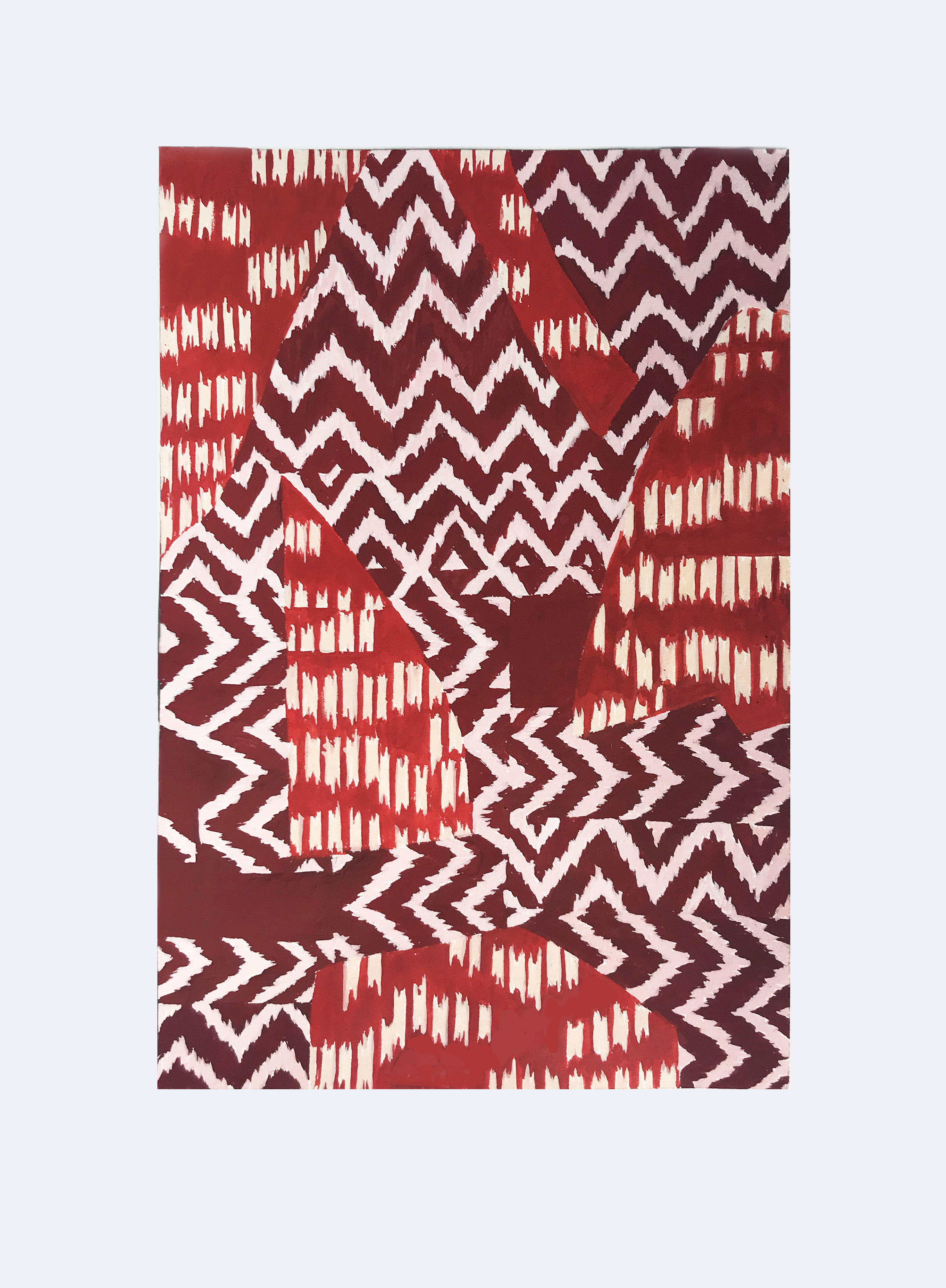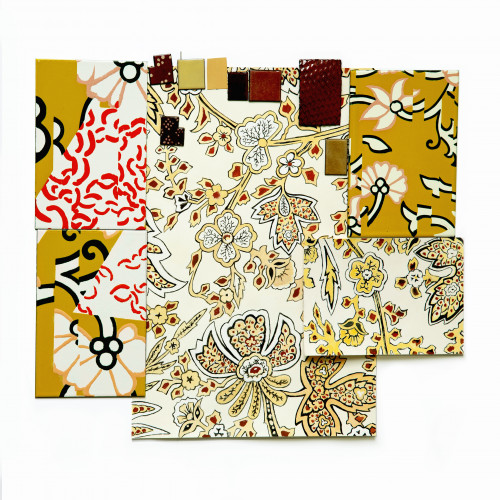Hannah Sabapathy
Raisa Kabir in Conversation with Hannah Sabapathy
The Harris Museum, Preston
Partner Reflection

Tell us a bit about your artistic work, discipline and background.
I am an artist whose practice focuses on pattern and colour, born and raised in Birmingham and now based in Dundee.
I originally trained as a printed textile designer and I worked for several years in the textile industry. After studying at the RCA my practice shifted to exploring different materials to create a series of sculptural furniture pieces. These were made using a range of techniques including screen printing, lacquering and laser etching. My work combines drawing, screen printing and rudimentary printing techniques to createunexpected collages of pattern. More recently I have begun to work with metal and vitreous enamels, exploring the underlying connotations of these materials. I often look at historic patterns and techniques. My practice moves between the worlds of craft, design and art often culminating in objects.

Why did you apply for the 20/20 project?
I have recently returned to my practice after being the main carer to my three children and I applied for the 20/20 project to give me the time to develop a practice that considers the political in pattern design alongside in depth research. I am interested in how the decorative arts and craft have been copied and appropriatedparticularly in relation to Indian textile design. All of this relates to my own South Asian heritage and understanding this in relation to design. This is part of a wider personal and professional reclamation and interrogation of identity. 20/20 also provides me with an opportunity to make these patterns and the issues surrounding their collection and collation more boldly visible.
What conversations, thoughts or feelings do you hope to encourage amongst your audiences during your residency?
I want to discuss ideas of appropriation, ownership and hybridity within the context of pattern design. I will be specifically looking at The Forbes Watson Volumes of Indian Textiles, which are in themselves an extensive collage of patterns. The issues surrounding these volumes are complex as not only are they intertwined with the strands already mentioned but they are also enmeshed in slavery, extraction, global trade and industry. I want to open up conversations about how design was/ is colonised and unravel what relevance these ideas still have for us today. I also hope to encourage thoughts about how these patterns can be reclaimed and a new outcome created.

Partner Reflection
Harris Museum, Art Gallery and Library
James Arnold, Programmes and Collections Manager
Nicola Hood, Contemporary Art Curator
Lindsey McCormick, Fine Art Curator
The Harris Museum, Art Gallery and Library first opened in 1893, as part of Preston City Council. Our collections are strong in fine and decorative art, costume and textiles, and regional history. Artists represented include J.M.W. Turner, Lucian Freud, Bridget Riley, Cornelia Parker, Lubaina Himid, Frank Auerbach, Maud Sulter, Maggi Hambling, John Bellany, Lucy Gunning and Shezad Dawood.
In October 2021, the Harris closed temporarily for a major redevelopment project called Harris Your Place and will reopen in spring 2025. The project includes making urgent repairs to the building and rethinking the function of spaces. Importantly, the project is an opportunity to create new dialogues and listen to different voices that challenge traditional narratives and ways of displaying the collections. We are working closely with a diverse range of community partners, including regional artists, to co-curate many of the spaces, as well as celebrating a sense of belonging, and encouraging discussion and visitor feedback after reopening.
New spotlight displays will explore previously silent narratives of colonialism, British Empire and the Transatlantic Slave Trade. We are working with and commissioning contemporary artists to make new work that questions and responds to the collections in new ways, including confronting histories of cotton manufacture, the importing of tea and sugar, and Britain’s military presence in Egypt. We have recently acquired works by Billie Zangewa, Azraa Motala, Hetain Patel, Thierry Oussou, Sunil Gupta, Shawanda Corbett, Christine Cherry, Jacqueline Bishop, and Emma Prempeh.
We were excited to have the opportunity to work closely with Hannah Sabapathy. The 20/20 project allowed time to build a strong relationship with Hannah, to get to know her practice and support meaningful engagement with the collections; in particular, the Textile Manufacturers of India volumes by John Forbes Watson. We are looking forward to displaying this major work in a prominent position in the reimagined Harris. In addition, a supporting display in our Special Collections Gallery will provide an insight into Hannah Sabapathy’s research and practice and highlight strong links with a new display that explores the history of cotton. We are committed to supporting Hannah’s future practice and research, building on an already strong relationship.
The 20/20 project is supporting curatorial practice as the Harris moves forward, especially in terms of methodologies around commissioning and collecting new work. We expect this will support change strategically through senior management, but we are in the early stages of this journey.
The Harris Your Place project has provided the opportunity to create the infrastructure to present new narratives and encourage conversations about collections. Reopening will be an opportunity to test the new ways of working in these spaces, and how effectively we respond as a team to give agency to visitor feedback. The project has starkly highlighted the items we do not have in the collection, and therefore whose story we cannot currently tell. Strategically, this learning and the conversations we will continue to have post-opening will shape the refresh of our collections development policy ahead of our next Museum Accreditation Return. This will inform the proactive collecting of items that anchor these narratives and diverse voices in the Harris. We hope that the commissioning of new work over the coming years will respond to these narratives and present them to our visitors in exciting and creative ways. Through this process staff will increase their confidence to interrogate and use the collection more effectively. The opportunity to be involved in the 20/20 project and Hannah Sabapathy’s residency have highlighted how we would like to work with artists in the future. Our learning includes the value of scheduling time for reflection and conversation. This has allowed a meaningful collaborative relationship to evolve with a really high-quality creative output.


